ISSN ONLINE(2278-8875) PRINT (2320-3765)
ISSN ONLINE(2278-8875) PRINT (2320-3765)
Muhammad Riazul Hamid
|
| Related article at Pubmed, Scholar Google |
Visit for more related articles at International Journal of Advanced Research in Electrical, Electronics and Instrumentation Engineering
Currently only 53 percent of total population in Bangladesh has access to electricity and per capita generation being 265 kWh is very low compared to some other developing countries. This shortage of energy hinders the growth of the country’s overall economy. However, Bangladesh has a good potential for harnessing renewable energy resources, solar and biomass in particular. Steps are taken to harness renewable sources of energy to make the country less dependent on the traditional fossil fuels. This paper presents current power generation scenario in Bangladesh, assesses the availability of solar irradiation and potential for power generation using solar PV panels. This paper also investigates into the current status of dissemination of PV based solar home systems (SHSs) in the rural areas of Bangladesh. Currently approximately 94 MW of power is generated from around 2 million SHSs already installed. Average growth rate of SHSs from 2003 up to December 2012 is around 58% which is among the highest in the world.
Keywords |
| Bangladesh, Dissemination, Renewable Energy, Renewable Energy Technology, Solar Home System, Solar Photovoltaic. |
I. INTRODUCTION |
| Bangladesh is predominantly an agrarian economy. As the contribution of industries is slowly growing, the share of agriculture to GDP has been decreasing over the last few years. Yet agricultural sector dominates the economy accommodating major rural labor force. To enhance employment opportunities, policies and incentives are there to facilitate the growth of both the agricultural and the industrial sector. However, generation and supply of electrical power in the country is lagging much behind the growing demand prohibiting sustainable growth of the economy. Bangladesh has limited proven natural gas reserve but for its energy need it hugely depends on imported fossil fuel. With the increase in the fuel price in the international market and reduction of gas reserve in the country, Bangladesh is forced to look for alternative sources of energy i.e., renewable energy resources. The government of Bangladesh has recently taken some renewable energy friendly policies to accelerate rapid growth of renewable energy technologies. Although investment costs of renewable are generally higher compared to fossil fuel alternatives, this option becomes economically viable when all externalities (e.g. environmental cost, health hazards etc.) and lower operating cost are taken into consideration [1]. Renewable Energy Policy of Bangladesh sets targets for developing renewable energy resources to meet 5 percent of the total power demand by 2015 and 10 percent by 2020 [1]. Bangladesh already has achieved some remarkable successes in the implementation of renewable energy technologies (RET). |
| This paper is organized as follow: Section I discussed the importance of utilizing renewable energy resources available in Bangladesh. Section II presents overall current power generation scenario including the share of public and private participation in generation sector. Section III discusses the contribution of different types of fuel in generating power in Bangladesh. Section IV assesses solar energy resources in Bangladesh. Section V highlights the role of Infrastructure Development Company Limited (IDCOL) which is playing the central role in disseminating solar home systems (SHSs) in rural areas of Bangladesh. Section VI discusses the achievements made so far in installing SHSs and revised target for future. Section VII presents an approximate estimate of power generation from already installed SHSs and makes future projection. Section VIII discusses the new opportunities for economic activities that opened up in the rural areas and suggests actions to remove barriers to accelerate this process of dissemination. |
II. CURRENT POWER GENERATION SCENARIO IN BANGLADESH |
| Currently only 53 percent of total population in Bangladesh has access to electricity and per capita generation being 265 kWh which is very low compared to other developing countries. However, in the last three years, the power generation has consistently improved. Table 1 shows the comparative data for the last four years. |
| Table 1 presents overall scenario of power sector over the four consecutive years [2]. |
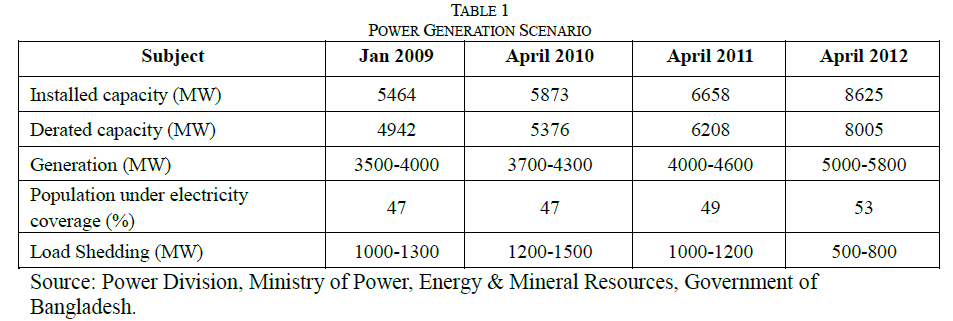 |
| At present there is high-unsatisfied demand for energy which is growing by more than 8% annually. The government of Bangladesh has declared that it aims to provide electricity for all by the year 2020 [3]. Considering the high demand the government has revised upward its power generation capacity for 2014 and 2021. In 2014, the power generation capacity will be 8622 MW and in 2021 it will stand at 22,500 MW [2]. In the recent past, the private sector has been encouraged to invest in the generation sector. Table 2 shows the contribution of public and private sector in the last few years [2]. |
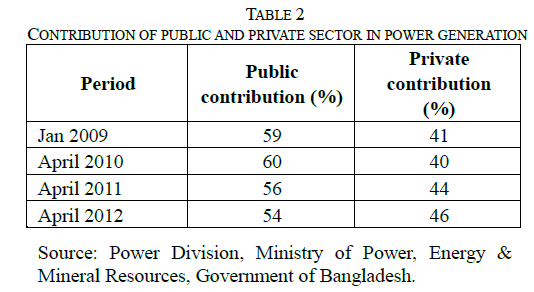 |
| Table 2 also indicates a gradual rise in private sector’s participation in the power sector. |
III. FUEL MIX IN POWER SECTOR |
| Natural gas is predominantly being used as main source of fuel in Bangladesh for power generation. However, percentage-wise its contribution has been slightly reduced in recent years with increased use of imported furnace oil in the rental power plants. This situation is putting huge pressure on the foreign currency reserve in the country. Fig. 1 shows the variation of share of different types of fuel in power generation over the last few years [2]. With the volatility in the fuel price in the international market and reduction of gas reserve in the country, Bangladesh is forced to look for alternative sources of energy i.e., renewable energy resources. Of all the renewable resources available in Bangladesh, solar energy and bio-energy looks most promising. Solar Home Systems (SHS) using solar photovoltaic (PV) cells have become very popular in the off-grid rural areas in Bangladesh. IDCOL is playing the central role in promoting this technology in Bangladesh through a number of partner organizations (POs). |
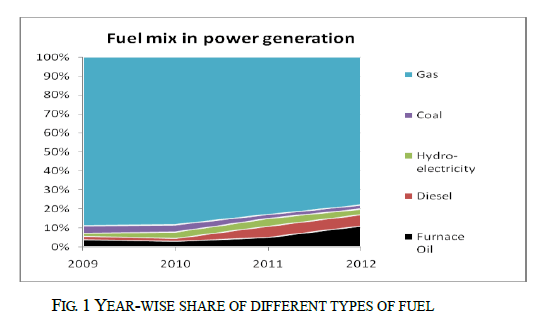 |
IV. ASSESSMENT OF SOLAR ENERGY RESOURCES |
| According to country report for Bangladesh “Promotion of Renewable Energy, Energy Efficiency and Greenhouse Gas Abatement (PREGA)” published in October 2003, annual amount of solar radiation in Bangladesh varies from 1,840 to 1,975 kWh/m2 [4]. According to this report, taking an average solar radiation of 1900 kWh per square meter, total annual solar radiation in Bangladesh is equivalent to 1,010 x 1018 J and the total yearly consumption of energy in Bangladesh was about 1,000 x 1015 J in 2003. This report also pointed out that even if 0.1% of the incident radiation could be utilized, total requirement of energy in the country could be met. Although yearly energy consumption in Bangladesh has increased in recent years, it is obvious that less than 1% of the incident radiation in Bangladesh can meet present day’s demand. |
| This report (PREGA) published in 2003 also calculated that taking 10% efficiency for the solar cell, the estimated PV electricity generation potential was 50,436 MW. This calculation was based on roof areas for dwelling houses and cattle sheds where solar PV panels could be fixed. With the increase of number of households by 2013, potential for PV electricity production has increased further. |
V. ROLE OF IDCOL IN DISSEMINATING SHS IN THE RURAL AREAS OF BANGLADESH |
| IDCOL is the largest local financer in infrastructure and renewable energy financing. IDCOL started its SHS programme in 2003. IDCOL is also involved in providing technical assistance and promoting capacity development of stake holders. Under renewable energy program, apart from SHS and domestic biogas plants, IDCOL has financed various other renewable energy projects such as [5]: |
| 250 kW biomass (rice husk) gasification-based power plant |
| 400 kW biomass (rice husk) gasification-based power plant along with a precipitated silica production plant |
| 470 kW biogas (from poultry litter) based power plants |
| 100 kWp solar photovoltaic based mini-grid |
| 47.3 kWp solar irrigation pumps |
| 50 kW biogas based power plant |
| Solar-diesel hybrid power system for 98 telecom BTSs. |
VI. SOLAR HOME SYSTEMS (SHS) |
| Panels within the range of 10-130Wp are being financed by IDCOL. Notably, 20Wp, 40 Wp and 50Wp are the popular panel sizes among which 50Wp is the most popular. Cost of a typical 50 Wp unit along with battery and other accessories is around Tk. 29,000 per unit (Exchange rate as on January 2013, Tk. 1 = US$ 0.012). IDCOL is providing around Tk. 2000 (USD 25) per unit as grant. From 2003 up to December 2012, total 1,953,886 numbers of solar home systems were installed under the finance of IDCOL (Source: IDCOL). |
| Fig. 2 shows a sharp increase in the number of total SHS installations financed by IDCOL in recent years. |
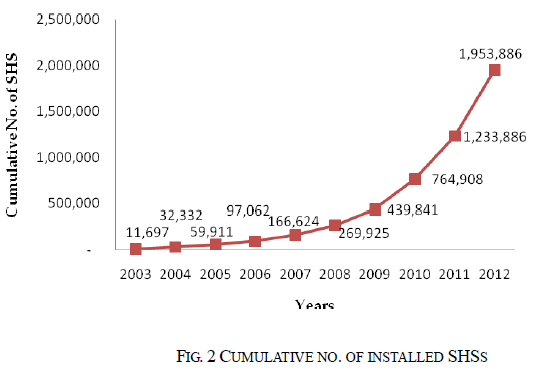 |
| Fig. 3 shows year-wise installations of SHSs in Bangladesh. It shows a sharp rise in the growth of number of yearly installation of SHS in recent years. |
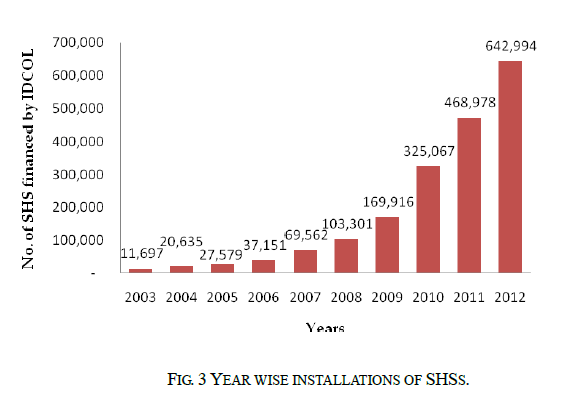 |
| IDCOL now has a revised target of financing 4 million SHSs by 2015 [5]. In 2012 alone, IDCOL has managed to finance 642,994 SHSs through its partner organizations. At this pace, in three years from 2013 to 2015, total installations in the next three years will be around 1,928,982. The cumulative total will be 3,882,868. This shows that with an extra push, IDCOL can achieve its target of 4,000,000 installations by 2015. |
VII. POWER GENERATION FROM SOLAR HOME SYSTEMS |
| A typical 50 Wp solar home system supports 4 tube lights (7 watts each) and a 17” Black and White TV set. From around 2 million SHSs already installed under IDCOL’s financing with average capacity 50 Wp, total generation capacity in December 2012 is approximately 94 MW. At present around 60,000 SHSs are being installed every month under IDCOL’s SHS programme. At this rate, by December 2015, total generation capacity from this SHS programme should reach about 200 MW. Introduction of solar PV systems has been in progress since 1980 but the total wattage up to December 2002 was just 1,000 kW [4]. In recent years, apart from SHSs, various other renewable energy projects such as biomass (rice-husk) gasification based power plants, biogas (from poultry litter and cow dung) based power plants; municipal waste based power plants are being implemented in Bangladesh. According to new regulations, every newly built high-rise building must install solar PV panels at the roof top before they get connection to electrical distribution lines. All these renewable energy projects are contributing in achieving the government’s target of producing 5% power from renewable sources by 2015 and 10% by 2020 as declared in the Renewable Energy Policy of Bangladesh. |
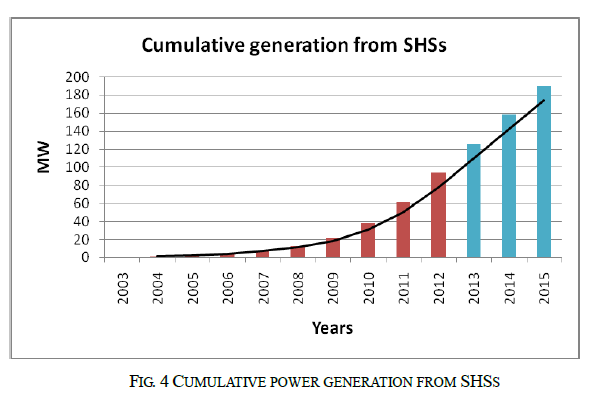 |
| Fig. 4 presents projected power generation from 2003 to 2015 if the current rate of installations is maintained. |
VIII. CONCLUSION |
| Current ongoing program of SHS is a great success in Bangladesh. As a result of this program new employment opportunities have been created in the rural areas and it also helped create new industries of SHS accessories i.e. solar PV batteries, charge controller, etc. In addition, generation of electricity from domestic biogas plants, poultry litter based biogas plants and large scale power generation from municipal waste will further add to the total contributed by renewable sources. Dissemination of renewable energy technology (RET) requires funding facilities to the users. Increase in subsidy will definitely enable more people to install SHS. Financial mechanisms should be devised for easy access to loans for installations of SHS in the rural areas. Local manufacturing of components should also be encouraged and appropriate tax and VAT rebates should be given to this industry. |
References |
|